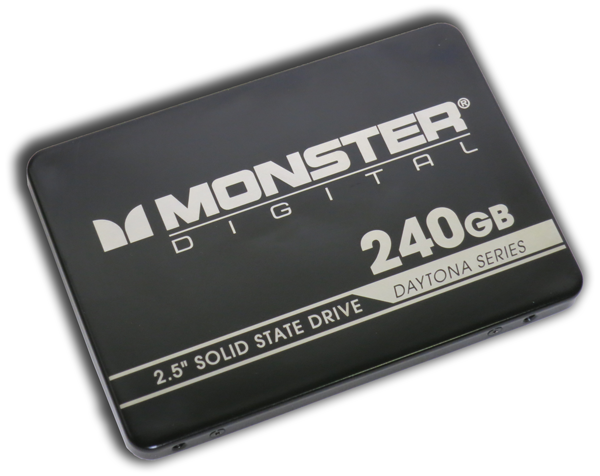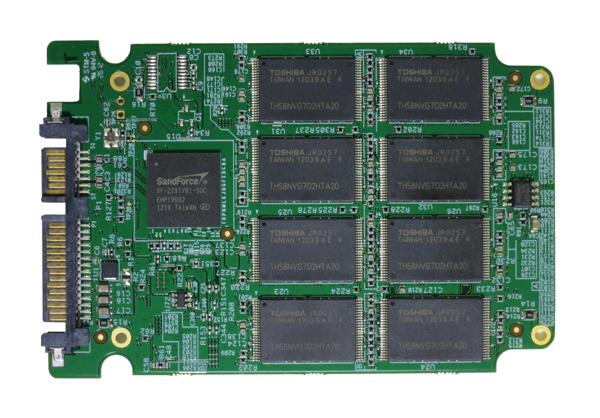Time To Upgrade: 10 SSDs Between 240 And 256 GB, Rounded Up
Monster Daytona
Monster is well-known for its cables, but it recently jumped into the world of SSDs as a SandForce partner. Like many of its competitors, the company offers two drive families: Le Mans and Daytona. The first is more enthusiast-oriented, employing Toggle-mode NAND from Toshiba. Naturally, it commands a higher price. The Daytona is mainstream, and shows up on Monster's site with “NCQASYNC” NAND.
Interestingly, when we open up our 240 GB Daytona sample, we find NAND from Toshiba. According to Monster, it's utilizing "legacy Toggle-mode NAND" with an interface speed of 40 MB/s. Although this is slightly less than asynchronous ONFi-compatible NAND, which can move up to 50 MB/s per channel, we're also dealing with a different interface. So, we can't assume that the Daytona is going to be slower than, say, Transcend's SSD320.
Monster's drive doesn't come bundled with anything else, but it is protected by a three-year warranty.
The Daytona presents us with benchmark results that are similar, but slightly faster than the competition sporting SandForce controllers and asynchronous ONFi interface-compatible NAND.
We did run into an interesting aberration while testing this drive, though. For some reason, 4 KB random write performance wouldn't change, regardless of the data we threw at it. The first sample we tested shipped with firmware 5.0.2, but wouldn't complete an update. Monster shipped out a replacement with firmware 5.0.5 that arrived at the last moment, resolving all of our issues. It’s not quite clear if our first sample was problematic, or if the firmware update alone fixed the drive's behavior. Currently, firmware version 5.0.2 is newest on Monster’s website, though the company tells us an update will be posted soon.
Get Tom's Hardware's best news and in-depth reviews, straight to your inbox.
Current page: Monster Daytona
Prev Page Corsair Neutron GTX And Neutron Next Page PNY XLR8 Pro And XLR8-
mayankleoboy1 get the cheapest, biggest you possibly can. Benchmarks exaggerate the difference between SSD's.Reply -
A Bad Day I agree. Unless if you're buying a glorified USB stick (there is a 128 GB stick) or an SSD with an OC'ed processor, the main factor that consumers should be concerned about is price per gigabyte.Reply -
A Bad Day EDIT: And reliability.Reply
"In order to install a new firmware that significantly boost performance and stability, you must backup all of your data because it will be wiped." -
Tanquen Yea, it’s getting a little out of hand. For 90% of the things 90% of people do on their PC, 200MBs+ read and write speeds just don’t mean much. There are too many other bottle necks going on. I messed around with a RAM drive using most of my 64GB of RAM and the read and write speeds are fun to test (4000MBs or so) but games and VMware sessions I launched from the RAM disc saw no noticeable improvement in launch times or anything else. Same goes for my 830 SSD drive. It’s fast but games and software I use for SCADA development just don’t see any real benefit. They are cool if you want to open 10 sessions of MS Word and 15 Internet Explorer and a bunch of other stuff at the same time but if you just open one instance of Excel and use it and the Photo Shop and use it and then a web browser and use it, you’ll never really see the difference. You have to benchmark it or have two PCs setting right next to each other to see that something started or saved a split second faster.Reply
At least with my 64GB of RAM and actually get 64GB of RAM unlike HDs and SSDs.
-
tomfreak unless the sandforce drive is priced a lot cheaper than the similar capacity non-sandforce SDD. I always choose the non-sandforce SSD. 16GB is a big deal in SSD.Reply -
stoogie until theres affordable 512gb ssd's then i wont get 1, my c drive is 360gb~ and i have 11tbReply -
sna TanquenYea, it’s getting a little out of hand. For 90% of the things 90% of people do on their PC, 200MBs+ read and write speeds just don’t mean much. There are too many other bottle necks going on. I messed around with a RAM drive using most of my 64GB of RAM and the read and write speeds are fun to test (4000MBs or so) but games and VMware sessions I launched from the RAM disc saw no noticeable improvement in launch times or anything else. Same goes for my 830 SSD drive. It’s fast but games and software I use for SCADA development just don’t see any real benefit. They are cool if you want to open 10 sessions of MS Word and 15 Internet Explorer and a bunch of other stuff at the same time but if you just open one instance of Excel and use it and the Photo Shop and use it and then a web browser and use it, you’ll never really see the difference. You have to benchmark it or have two PCs setting right next to each other to see that something started or saved a split second faster.At least with my 64GB of RAM and actually get 64GB of RAM unlike HDs and SSDs.Reply
to see the difference you will need to put the system itself on RAM Disk. not only the installed programs.
-
Where are Samsung SSDs ? Especialy model Samsung 830- 256GB which is on sale in Europe for 160-180€. That is best offer, reliable, faster than basic 840. Get some MB with Z77 chipset and you can RAID them with TRIM support. 2x256 for 330€ is so awesome with 1035Mb/s read in RAID 0. I tested it on Gigabyte Z77-UP4 TH, its a shame that there are only 2x6Gbit ports so 1x840 Pro + 2x830 in RAID 0 is impossible on this MB without SATA2 speed loss on remaining SATA ports. This was my scenario for fast gaming /500GB Steam inventory/ : Raptor, later RAID 0 HDDs, later Velociraptor, next 128GB SSD + 1GB Samsung HDD cached by OCZ Synapse 64GB /totaly unreliable/. So I ended up with 1x boot SSD + 2x SSD in RAID 0. Maybe I am little bit offtopic but any ideas how to "live" with increased Steam inventory and keep it fast enough ? Steamover SW is not reliable for me. Thanks for nice article.Reply
-
ojas ReplyWhen Thomas, Don, and Paul prioritize the parts for their quarterly System Builder Marathon configurations (the next of which is coming soon, by the way)
Wait, SBMs are fine, but where oh where went BestConfigs? -
-Fran- I went for a Vertex4 and placed it in my notebook. What a boost. I'd say it also helped improve battery life.Reply
For a Desktop, I don't have a particular use TBH. I have a RAID0 with 2x512GB WD's and it works amazingly good (and fast as well). I'd say, for desktops, SSDs are still not viable because of price, unless you clench your teeth with loading times or such, hahaha.
Cheers!


